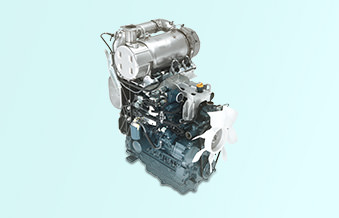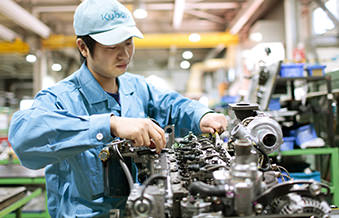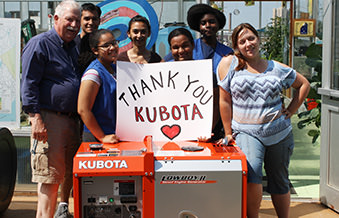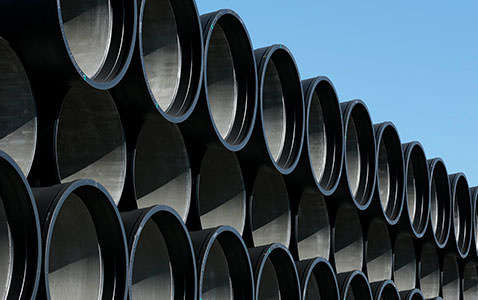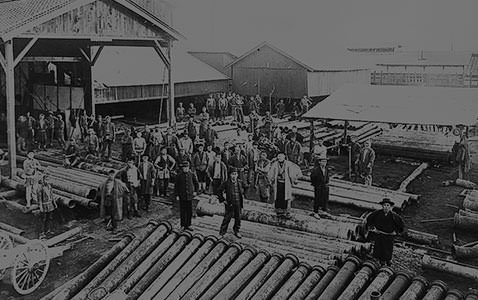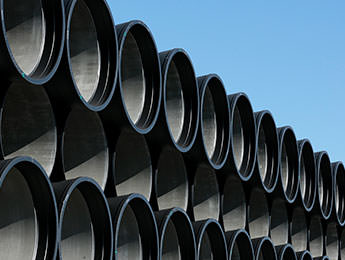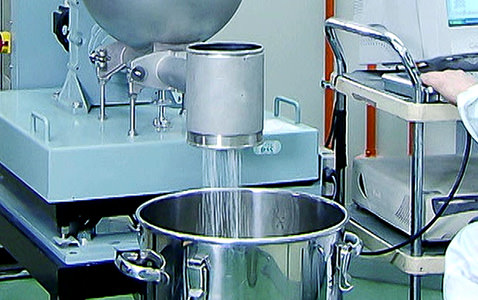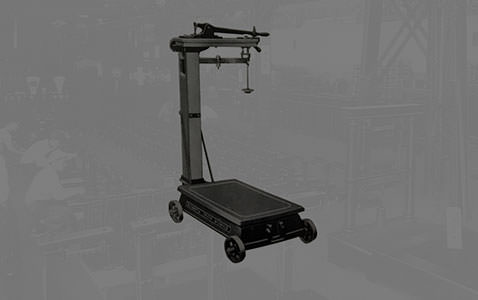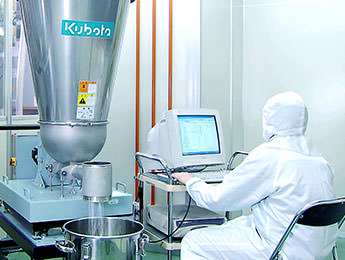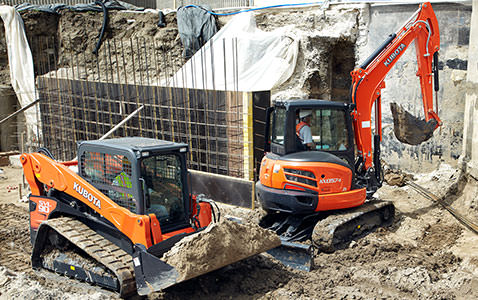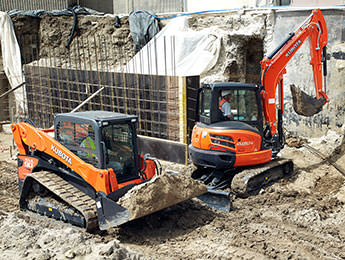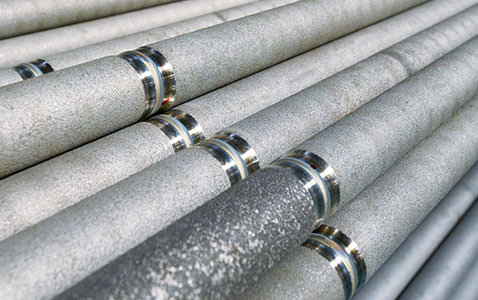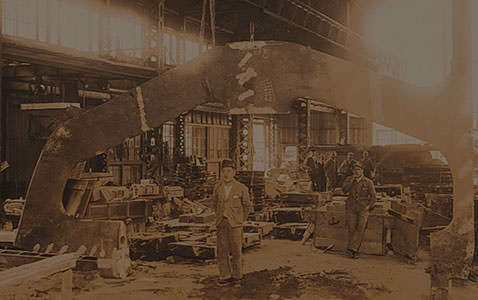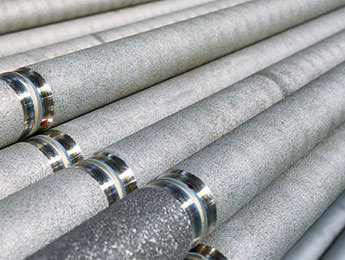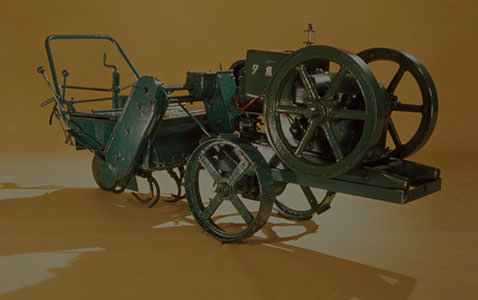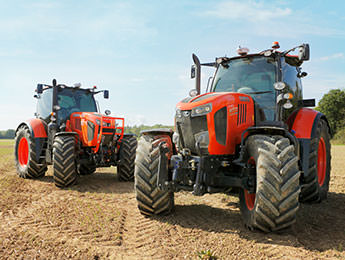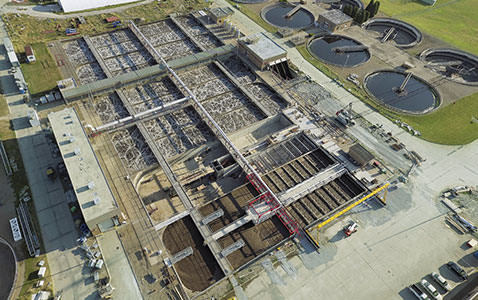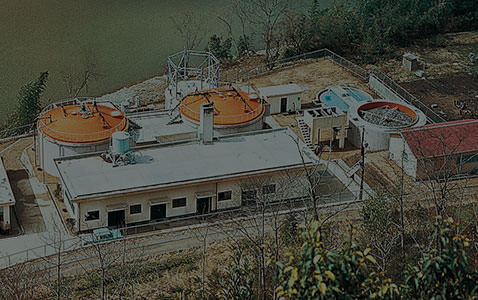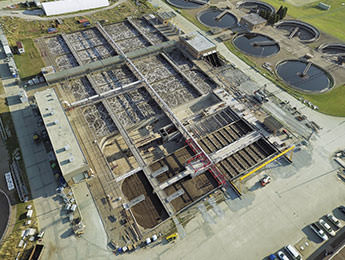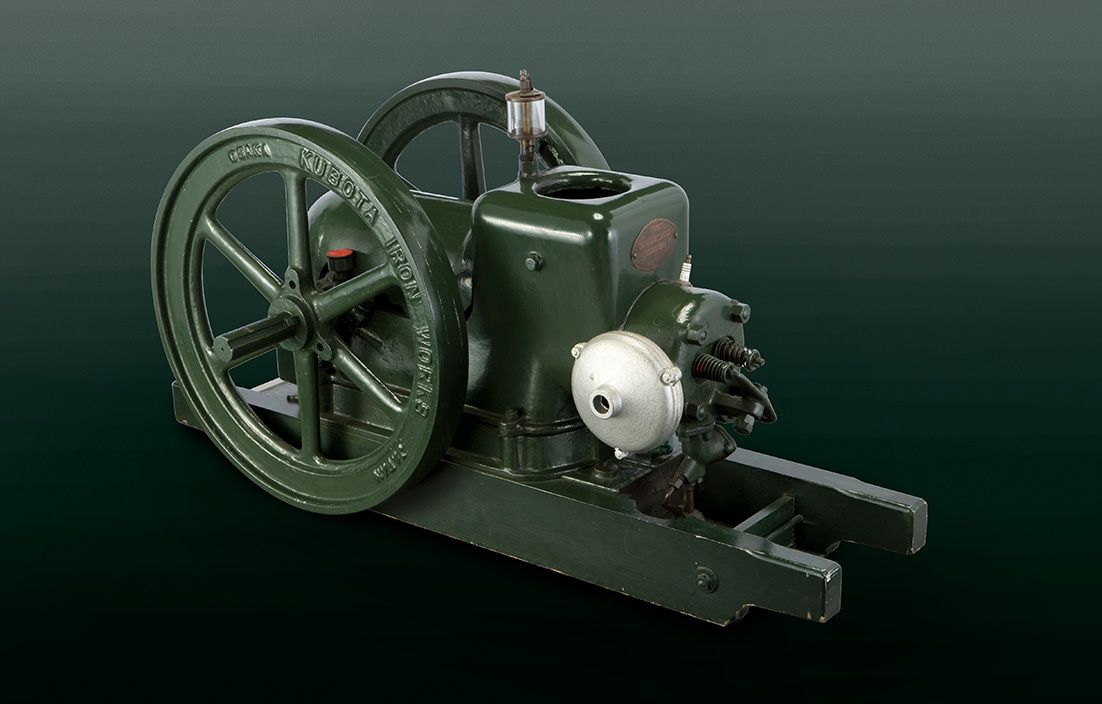
1920s
The Origin of Kubota’s Agricultural Machinery.
Starting the Domestic Production of Engines
Kerosene Engines for Agricultural/Industrial Use
Kubota’s first engine for agricultural/industrial use
The depression brought on by World War I also hit hard Kubota’s core businesses—casting, iron pipes, and machinery. As the company sought to start a new business, kerosene engine were showing rapid growth in the market. An approach from an import agent about the domestic production of engines led to a new opportunity, opening a new door for Kubota.
Amidst the Depression Following World War I, People Sought Agricultural and Industrial Kerosene Engine in Wake of the Drought that Struck Japan
It is said that the first kerosene engine that was introduced to Japanese agriculture was imported from the United States in 1915. From then on, US-made engines were used as the source of power for grain-threshing, rice-hulling, and water-pumping. Kubota’s production of kerosene engine for agricultural and industrial use goes back to 1922. It coincided with the great drought that struck the western side of Japan, and the demand for oil engines increased with the sudden spread of water pumps. The economy went downhill as a result of the war, and Kubota was seeking for a strong core business in place of the machinery division. Sugiyama Trading Company, an importer of engines, then approached the company, and Kubota started manufacturing domestic engines.
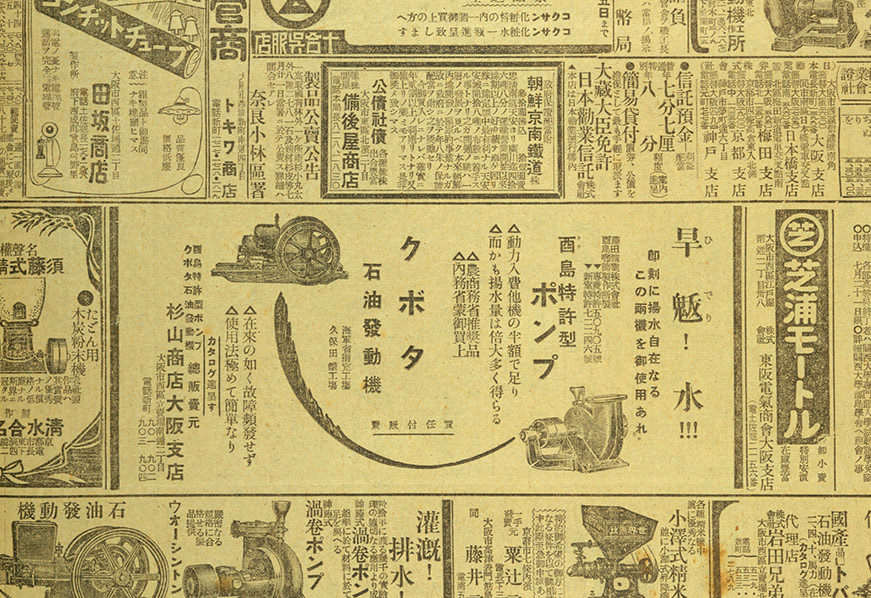 Kubota’s kerosene engine appeared next to a water pump on a newspaper ad
Kubota’s kerosene engine appeared next to a water pump on a newspaper ad
Kubota Started Producing Engines Using the Facility and Technology of the Machinery Division, Becoming a Core Player of the Industry in No Time
Capitalizing on its advanced casting technology established since its founding and utilizing the machinery division’s facility equipment and manufacturing technology, Kubota started to develop engines in one corner of its main factory’s warehouse. Pursuing an original, small-size engine with little noise, the company released the 3-horsepower kerosene engine "A" for agricultural use in 1923. Its sales rose steadily as a power source for irrigation pumps and rice hullers, expanding its lineup. Kubota continued to grow steadily, developing an engine for fishing boats in 1927 and broadening its market. The engine Kubota developed, applying technology cultivated through water pipe casting, received high ratings at expositions and competitions, and Kubota became a central player in the industry, despite its late entry into the market.
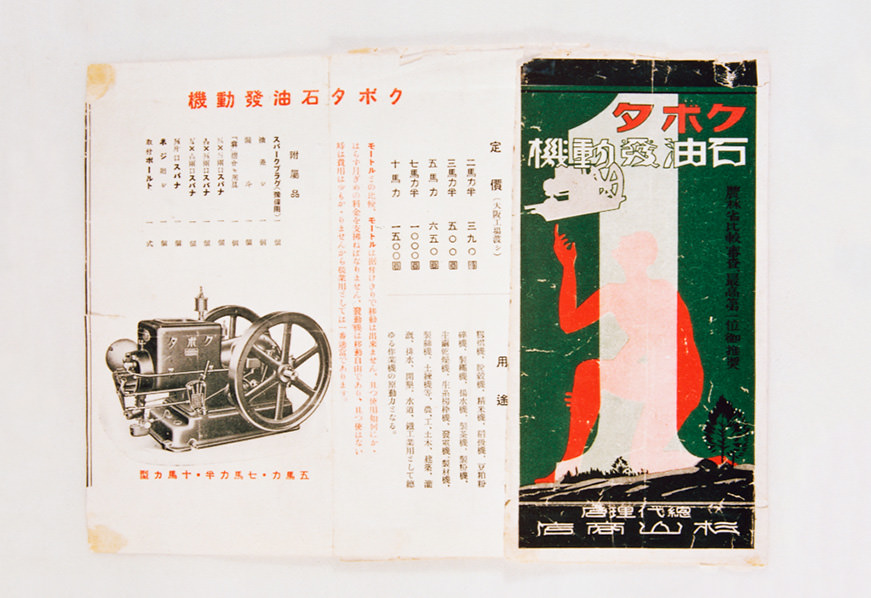 An kerosene engine catalog, highlighting Kubota winning first place
An kerosene engine catalog, highlighting Kubota winning first place
at a competition sponsored by the Ministry of Agriculture and Forestry
1930s
Industrial Engines Shift from Gasoline to Diesel
In addition to such qualities as durability and water/dust resistance, industrial engines require high standards of maintainability and stability. Compared to kerosene engines, diesel engines could provide these qualities at a much higher level, and soon became the norm for industrial engines. Accordingly, Kubota started developing diesel engines, as well.
Scroll to See Next Story
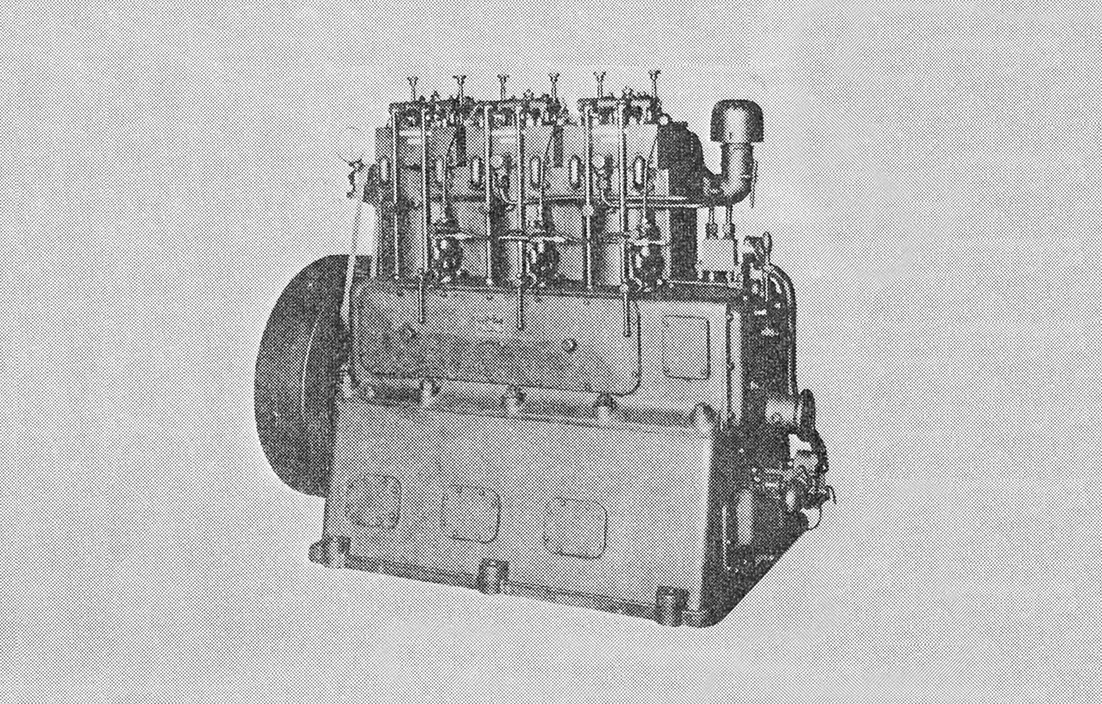
1930s
Expanding the Production of Diesel Engines
Diesel Engine
50-Horsepower Patented Acro Diesel Engine
During this period, the heavy chemical industry such as iron casting, automobile and machinery developed in Japan. Applying the manufacturing technique for kerosene engine, Kubota, which had been producing marine diesel engines, started manufacturing Acro Diesel Engines at the Funade-cho plant. Thus, it made its way into the field of diesel engines for land use.
From Marine to Land-Based. Making Its Way to a New Field in Diesel Engines, Developing Them as a Power Source for Agriculture
In Japan, fishing boats installed with motor engines were in use since the late Meiji Era, and, toward the end of World War I, the motorization of fishing boats rapidly increased along with the size of the vessels. In time, fishing vessels transitioned from motor-run to diesel-powered in order to enhance fuel efficiency and operation. Taking note of this transition to diesel, Kubota applied its kerosene engine manufacturing technology as well as its technology of and experience in steam engines, which it had discontinued, to begin developing marine diesel engines around 1927. Later on, it made its way into the field of land-based diesel engines for water pumps and sawmill machines, etc., receiving high recognition in the market.
Responding to the Increasing Demand for Engines by Establishing Asia’s Greatest Factory Specializing in Engine Production
As the economy within the agricultural community showed signs of recovery and the demand for engines increased, Kubota established a modern, state-of-the-art plant dedicated to engine production in Sakai, in order to respond to this shift. The Sakai plant embodied Kubota’s earnest hope to develop the machinery division to follow in the footsteps of the iron pipe division, which was at the top of its industry. The plant implemented a centralized process management system that oversaw the entire process that took place in the plant and a conveyor belt system, which came from Kubota’s experience in automobile manufacturing. The conveyor belt system was the first, aside from automakers, to be implemented by a private company in Japan, and, since its full-scale operation in 1938, it had multiplied the plant’s production capacity, producing 55% of the engines in the domestic market.
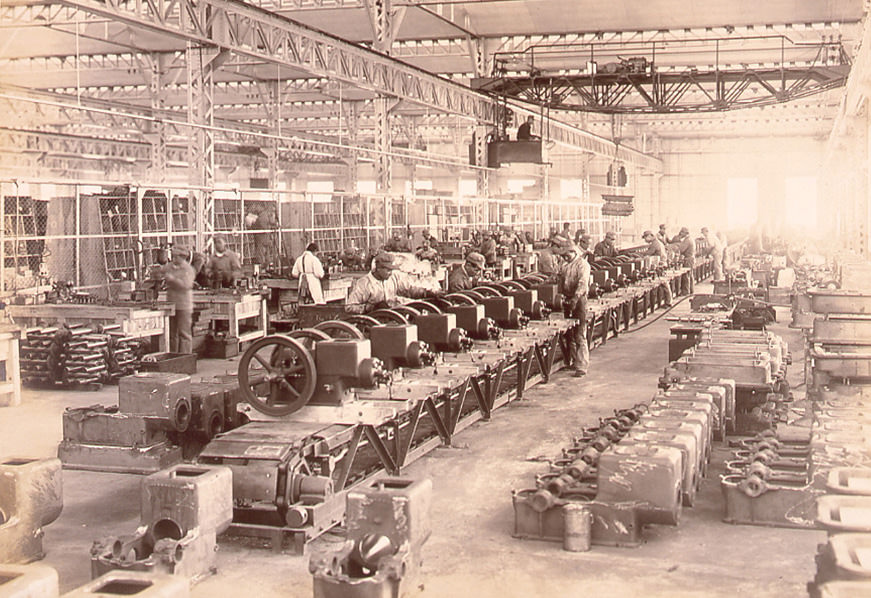 Conveyor-belt assembly line in the Sakai plant,
Conveyor-belt assembly line in the Sakai plant,
which employed state-of-the-art equipment of the time
1950s
Engines Become the “Heart” that Sustains Industries
A few years after the end of the war, the Japanese economy recovered from its initial chaos following the war and entered into an era of free competition. Engines, which contributed to the greater production of crops, were appreciated, and its demand increased explosively. Kubota also resumed the manufacturing of engines, which served as the “heart” that sustained Japanese industries.
Scroll to See Next Story
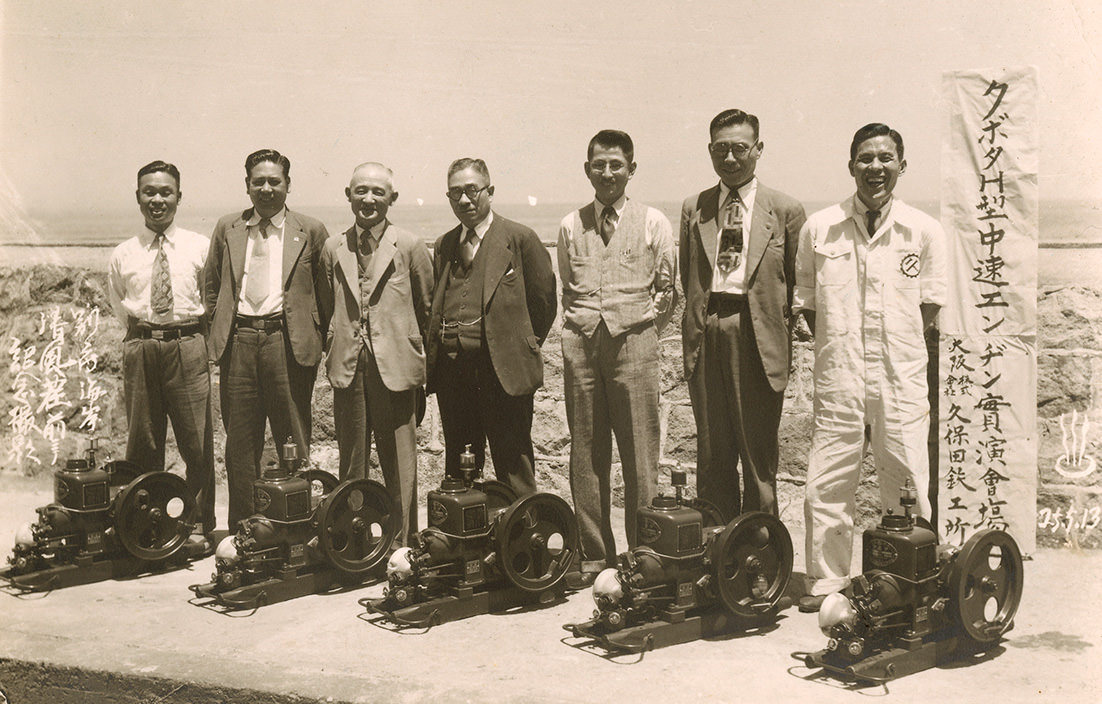
1950s
The First Medium-Speed Engine
in the Industry is Made
Horizontal Type Water-Cooled Diesel Engine
Medium-Speed H-Type Oil Engine Demonstration held in 1950
In the 1950s, government price and distribution control were abolished, and Japan entered a free market era. At the time, kerosene engine was the star of the market, and farmers longed for an engine that was portable and simple to operate. Kubota responded to those needs with its technical sophistication.
The Age of Free Competition Arrives. Kubota Drives Forward in Order to Develop Products that Respond to Farmers’ Demands.
Around 1950, as the postwar chaos subsided and Japan progressed toward reconstruction, the production of food increased, and the government no longer needed to strictly control the market. This year, the price and distribution regulations that the government imposed were lifted, and free competition began. Corporations gained the freedom of determining production, sales, and price, and people were able to purchase products they desired. kerosene engines were highly popular in the market at the time. Kubota, which had listened to farmers’ voices, realizing their wishes through research and technology, committed to realizing “a portable, light-weight engine that was easy to operate.”
Received the Minister Award with the Industry’s First Water-Cooling, Medium-Speed Engine. Improvement Continued in Developing More Compact and Lightweight Engines
The industry’s first H-Type horizontal type water-cooled diesel engine, which was completed in 1950 was chosen for the Minister’s Award at the Ministry of International Trade and Industry’s comparative performance test. This year, Kubota also released the 40kg SH-Type Ultra-Mini Engine, which was lightweight and easy to transport. In 1955, we released the N-Type Water-Cooled Gasoline-Kerosene Engine with a radiator, which automatically switched its fuel from gasoline to oil. As for air-cooled systems, we produced the 4-Cycle Gasoline Engine, which enabled continuous operation at high output. Engine production at the Sakai plant recorded 3,950 in one month in 1953 and exceeded 7,000 in a month the following year, sweeping the market.
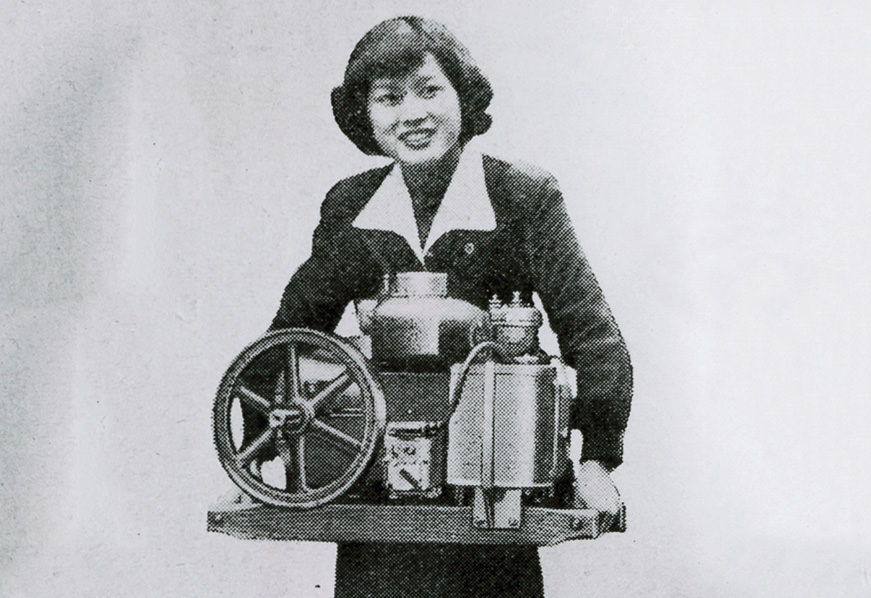 40kg, lightweight SH-Type Ultra-Mini Engine
40kg, lightweight SH-Type Ultra-Mini Engine
1970s
The Dawn of the Era of Tractors and Combine Harvesters
With a worldwide food crisis that took place in 1972, the demand for agricultural machinery rapidly increased. New demands for tractors and combine harvesters were especially high, and the “era of tractors and combine harvesters” began. Kubota’s agricultural machinery became explosively popular, and the engines were the heart that sustained them.
Scroll to See Next Story
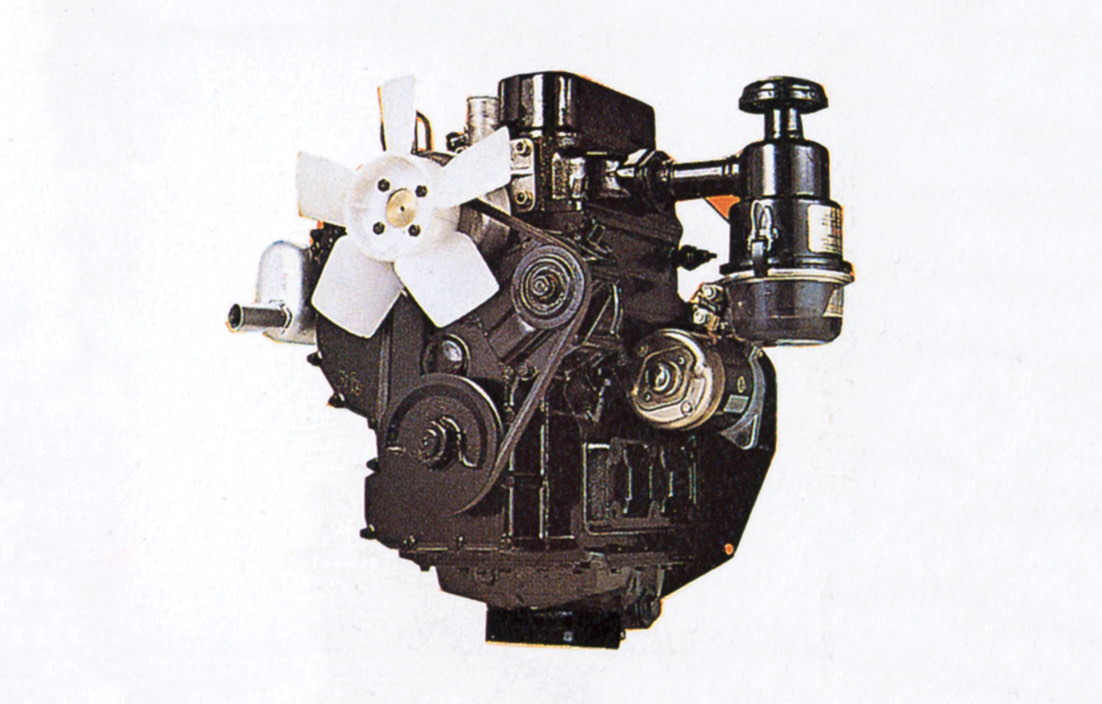
1970s
The Extraordinary Growth of Agricultural Machinery
and the Development of Engines
Vertical Type Diesel Engine
The Vertical 2-Cylinder Diesel Engine, which was installed in the Ultra-Compact 4-Wheel Drive Tractor B6000
Since rapid economic growth caused the outflow of rural population, the demand for agricultural mechanization continued to increase. With a growing concern over worldwide food shortage on top of that, the agricultural machinery boomed. What sustained the revolutionary transition to the “era of tractors and combine harvesters” or “agriculture as driving work” was the development of the engine—the heart of the machinery.
As “Agriculture as Driving Work” Became Mainstream, Kubota Developed High-Demand Tractor and Combine Harvester Engines One After Another
As the world faced food shortage caused by unseasonable weather since 1972, Japan revised its agricultural policy. As the government increased the producer’s rice price, agricultural machinery boomed nationwide. It was a time when agriculture was transitioning from a “walking task” to a “driving work,” and the demand for high-performing equipment—mainly tractors and combines—surged, with lines being formed at dealerships. Kubota, who was required to mass-produce engines with reduced vibration and noise, decided to expand its production facilities and adopted new design methods in order to both develop excellent engines and strengthen its productivity.
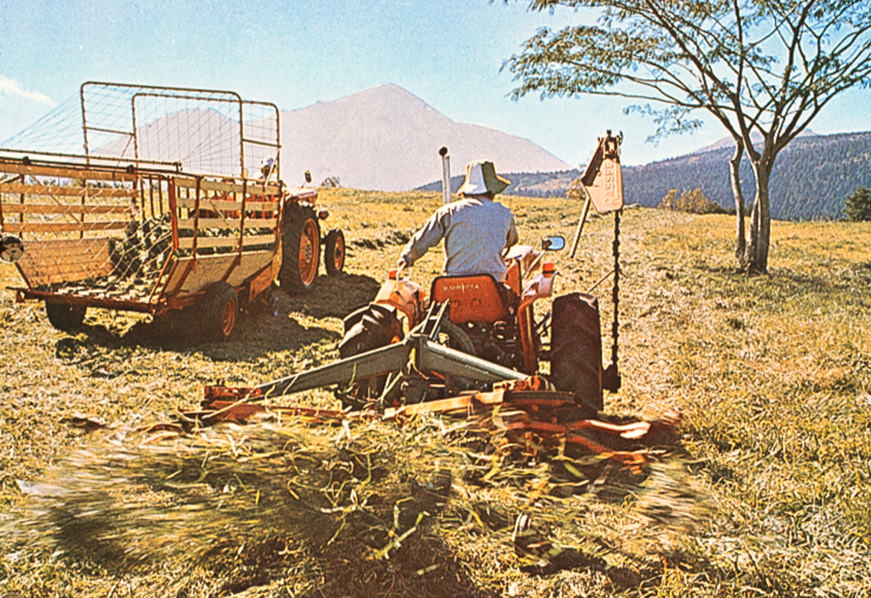 The demand for engines suddenly rose as
The demand for engines suddenly rose as
the agricultural machinery boomed in country
Established the Quality Standard for Kubota’s Tractor Engines
—Compact, Multiple-Cylinder, and Reduced Vibration/Noise
The driving force behind the realization of high-performing equipment was the various engines that functioned as their hearts. Kubota developed engines one after another, based on the characteristics of each equipment, such as the LH480H Air-Cooled Kerosene Engine for combine harvesters, K37T 2-Cycle Gasoline Engine for Rice Transplanters, Z750 Vertical 2-Cylinder Diesel Engine for L1500 Tractors, and the ZL600 Vertical 2-Cylinder Diesel Engine for Bulltra. When it developed L1500, it simultaneously developed multiple models for the first time. This created the foundation for Kubota’s quality standards encompassing compactness, multiple cylinders, and reduced vibration/noise, which were later applied to its tractor series.
1980s
The Maturing of the Agricultural Equipment Market
As the use of tractors and combine harvesters spread, the market for agricultural machinery matured in Japan. In addition, with the second rice acreage reduction program, the Japanese government promoted the conversion to such crop production as barley and soy, and new demands for agricultural machinery rose. Kubota expanded its lineup of engines, responding to the diversifying needs of farmers.
Scroll to See Next Story
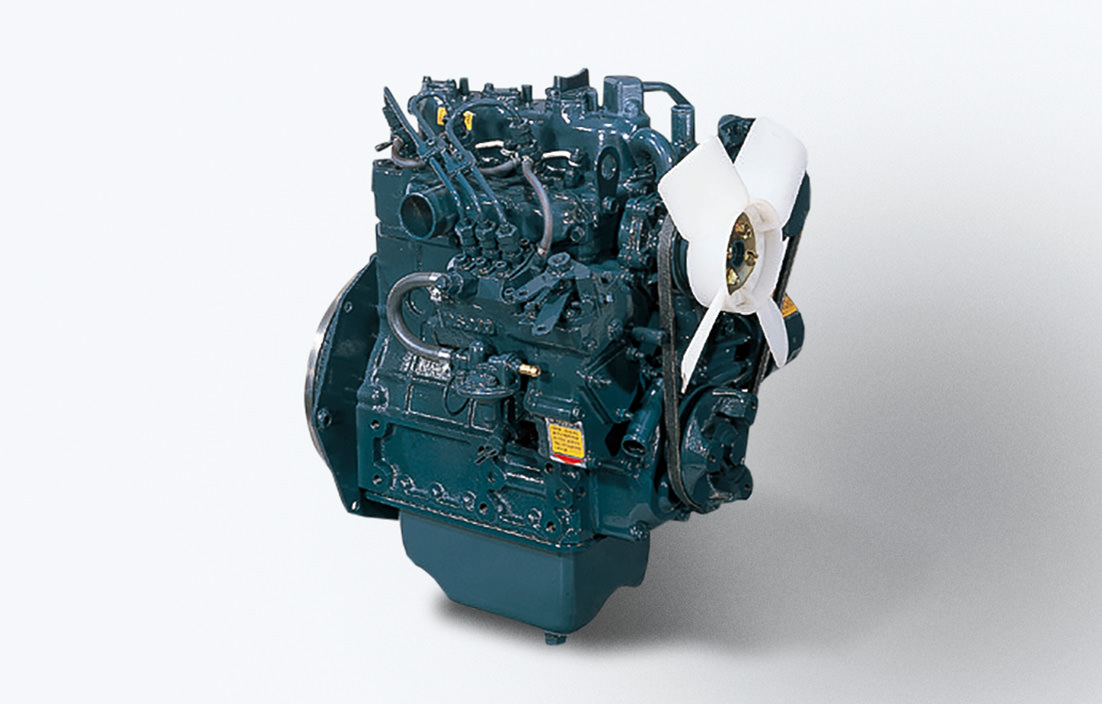
1980s
A Leap to the World Stage as an International
Manufacturer of Compact All-Purpose Engines
Super Mini Series
The Multiple-Cylinder Diesel Super Mini 62.2mm Stroke Series, which was the world’s smallest engine at the time it was released
While Kubota advanced with the corporate slogan, “Pursuing a promised future with our technological strength," celebrating the 90th anniversary of its founding, the market for agricultural equipment matured, transitioning from an age in which manufacturers provided machinery, to one in which they provided ‘operation.’ In order to respond to the diversifying needs, Kubota expanded its lineup of engines with different horsepower and fuels.
Amid Rising Demands for Diverse Models and Features, the “Extremely Small and Fuel-Efficient” Super Mini Becomes an Industry Benchmark
As Japanese rapid economic growth came to an end and major agricultural equipment became prevalent, demands for diverse models and features rose. Applying such high technology as mechatronics, Kubota led the matured market. The reversible tractor, which was developed in 1983, allowed users to attach the implements to the rear and operate the same way as in the front. In addition to this originality, the direct-injection, water-cooled diesel engine installed, which achieved high fuel efficiency, drew the public’s attention. Kubota’s “Super Mini” Series, which were the smallest, cleanest, and quietest engines among Kubota’s lineup, became the industry standard for small diesel engines.
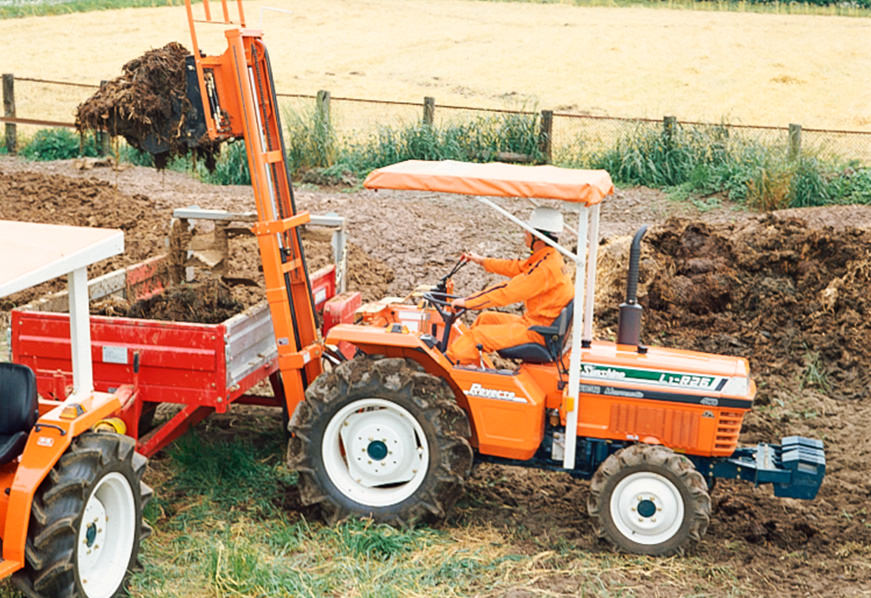 A reversible tractor installed with direct-injection, water-cooled diesel engine,
A reversible tractor installed with direct-injection, water-cooled diesel engine,
which achieved high fuel efficiency
With Sakai Bayside as its New Base, Kubota Leapt to the World Stage as an International Manufacturer of Compact All-Purpose Engines
In the process of expanding the engine business, Kubota established a goal to “become an international manufacturer of compact, all-purpose engines” and launched the “Sakai Rinkai Plant” project team in 1983. The Sakai Rinkai Plant was thoroughly dedicated to realizing low cost and high quality that surpassed notable international competitors, pursued high-mix, low-volume production, responding to diversifying market needs, and optimized all facilities and product management system. It started its operation in 1985 and produced up to 500 thousand engines in a year. In 1987, it reached a total production of 10 million engines. It had been 65 years since Kubota started manufacturing kerosene engine for agricultural use in the Funade-cho Plant in 1922.
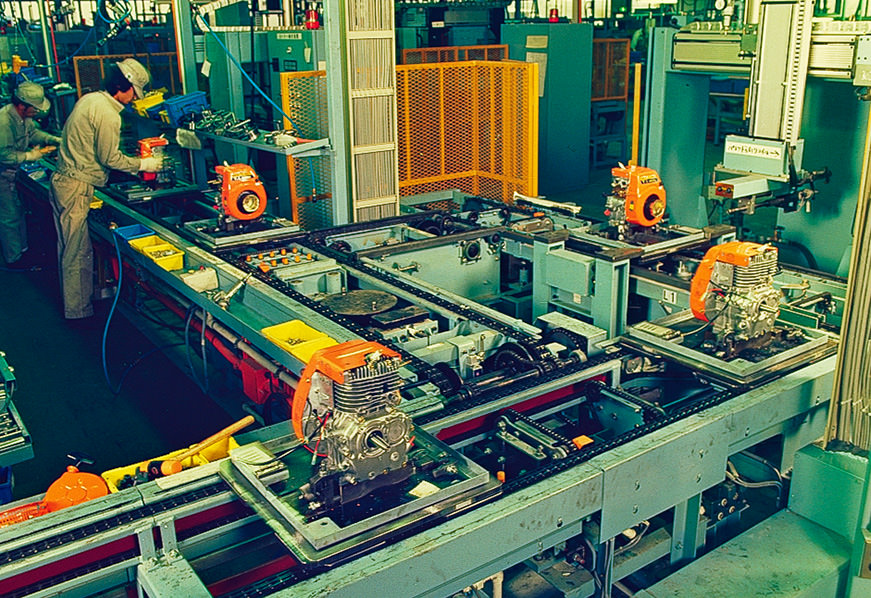 The assembly line for air-cooled gasoline engines in the Sakai Rinkai Plant
The assembly line for air-cooled gasoline engines in the Sakai Rinkai Plant
1990s-
The Strengthening of Environmental Regulations
Rapid economic growth caused pollution, and environmental protection became an issue that needed to be addressed not only by Japan but also on a global scale. As engine manufacturers responded to strict regulations, Kubota proactively addressed the issue for the sake of Earth’s future as on of the industry leaders.
Scroll to See Next Story
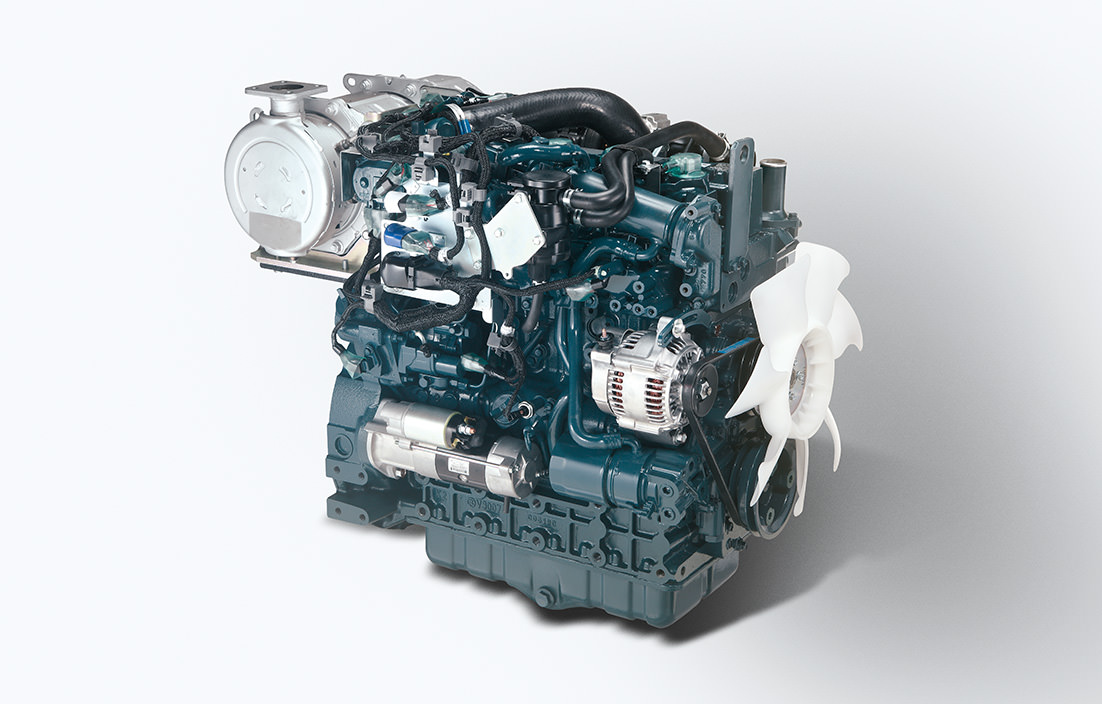
1990s-
Opening the Future
for Industrial Diesel Engine
E-TVCS Combustion System
Kubota’s engine installed with DPF meeting the EU Stage V emissions standards taking effect in 2019
The development of the society and industry, at any age, has been within the context of the natural environment. Kubota has contributed to environmental conservation and social infrastructure development since its founding. Today, with stricter emission regulations being called for around the world, not only is Kubota developing low emission engines but is also proactively implementing various other emission solutions, looking ahead to the future.
The First Engine Manufacturer in the World to be Granted Approval, Prior to the Implementation of Emission Regulation
In the field of diesel engines, manufacturers are competing at a high level not only to improve the engine itself but also to develop technology with a focus on emission reduction, looking into the future. Regulations were put on passenger vehicle engines starting in the mid-1970s with the purpose of protecting the environment. Similarly, this has extended to industrial diesel engines, and, in January 1995, the CARB ULGE (California Air Resources Board’s Utility, Lawn & Garden Equipment Engines) emission regulations below 25 horsepower. Kubota was the first engine manufacturer in the world to be granted approval, prior to its implementation.
Responding Quickly to Increasingly Strict Regulations with Kubota’s Original Technology, Creating Engines with Superior Value and Easy Installation
Kubota, which had been developing clean diesel engines from both design and production aspects at the time, invented its own E-TVCS combustion chamber (Kubota’s original combustion system) and improved its fuel injections parts, etc., passing the CARB ULGE emission regulations in 1993. It received much recognition for providing an environmental solution technology that would remain in the developmental and technological history of diesel engines. Since then, Kubota has always taken prompt action, obtaining certification for conforming to EPA’s federal emission standards as well as other increasingly strict emission-related standards in such countries as Europe and Japan. It rapidly responded to stricter regulations by developing an original combustion system, while maintaining the easy installation and creating added value.
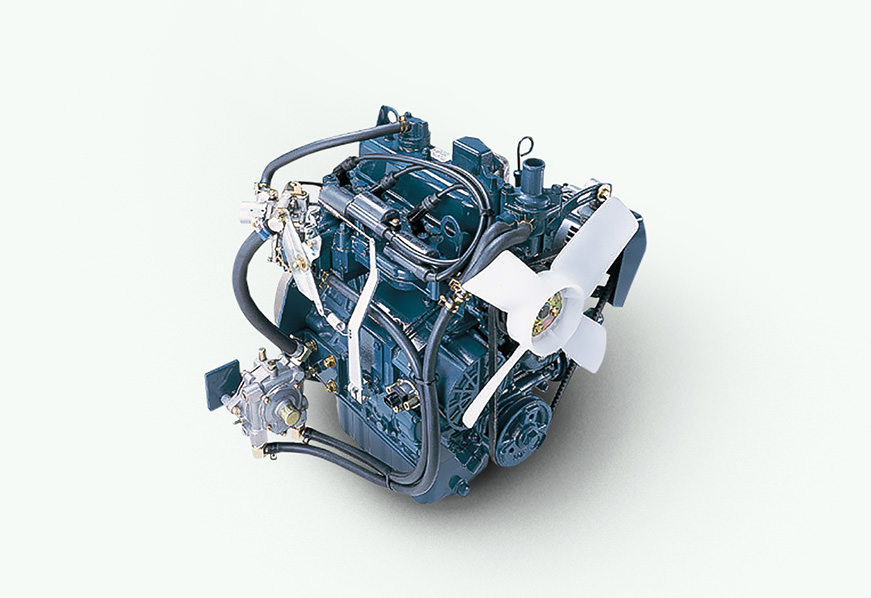 Dual Fuel Engine developed in 2001, which meets U.S. LSI emission regulations
Dual Fuel Engine developed in 2001, which meets U.S. LSI emission regulations
Realized Both Decreases in Emission and Increase in Vehicle Size/Horsepower. Future Kubota Engines Made Possible By Synergizing Different Areas of Technology
In addition to responding to increasingly strict emission regulations, Kubota is entering the dry-field equipment market by increasing its tractors’ size and horsepower. This—all while meeting emission standards—is made possible by Kubota’s broad technical expertise in such fields as electronics and chemistry. Kubota will continue its challenge as the top and irreplaceable manufacturer in the industry.
